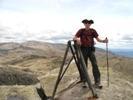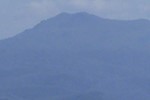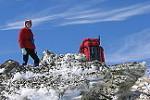This is in NSW but I'll throw it out to the collective wisdom of the wider community. This plant (red flowers) is growing on Guthrie Ridge just below Mt Guthrie, near Charlotte Pass in Kosciuskzo NP. I have also seen it elsewhere around the Main Range. My Australian Alps plant field guide doesn't list it, and I haven't found anything online, so I'm at a loss. Anyone know it?
Can anyone ID this plant? - Kosciuskzo NP alpine area
Forum rules
The place for bushwalking topics that are not location specific.
The place for bushwalking topics that are not location specific.
9 posts
• Page 1 of 1
Can anyone ID this plant? - Kosciuskzo NP alpine area
John W
In Nature's keeping they are safe, but through the agency of man destruction is making rapid progress - John Muir c1912
In Nature's keeping they are safe, but through the agency of man destruction is making rapid progress - John Muir c1912
-

johnw - Lagarostrobos franklinii

- Posts: 9031
- Joined: Wed 23 Jan, 2008 11:59 am
- Location: Macarthur Region - SW Sydney
- Region: New South Wales
- Gender: Male
Re: Can anyone ID this plant? - Kosciuskzo NP alpine area
Hard to say from the pic but maybe some sort of dock? Rosy dock (Acetosa vesicaria).
Sheep Sorrel ( Acetosella vulgaris) and Rumex spp. (Clustered Dock) has been noted in KNP.
See http://www.environment.nsw.gov.au/resources/alpineresorts/20070596App12.pdf
Sheep Sorrel ( Acetosella vulgaris) and Rumex spp. (Clustered Dock) has been noted in KNP.
See http://www.environment.nsw.gov.au/resources/alpineresorts/20070596App12.pdf
-

Avatar - Athrotaxis cupressoides

- Posts: 279
- Joined: Sun 07 Jul, 2013 5:21 pm
- Location: NE Melbourne
- Region: Victoria
Re: Can anyone ID this plant? - Kosciuskzo NP alpine area
Rumex I think - exact species unknown. Invasive exotic. Sigh.
Cheers
Roger
Cheers
Roger
-

rcaffin - Athrotaxis selaginoides

- Posts: 1226
- Joined: Thu 17 Jul, 2008 3:46 pm
Re: Can anyone ID this plant? - Kosciuskzo NP alpine area
Avatar wrote:Hard to say from the pic but maybe some sort of dock? Rosy dock (Acetosa vesicaria).
Sheep Sorrel ( Acetosella vulgaris) and Rumex spp. (Clustered Dock) has been noted in KNP.
See http://www.environment.nsw.gov.au/resources/alpineresorts/20070596App12.pdf
rcaffin wrote:Rumex I think - exact species unknown. Invasive exotic. Sigh.
Cheers
Roger
Thanks very much Avatar and Roger, sadly I suspect you are correct
Last edited by johnw on Tue 06 Mar, 2018 12:34 pm, edited 1 time in total.
John W
In Nature's keeping they are safe, but through the agency of man destruction is making rapid progress - John Muir c1912
In Nature's keeping they are safe, but through the agency of man destruction is making rapid progress - John Muir c1912
-

johnw - Lagarostrobos franklinii

- Posts: 9031
- Joined: Wed 23 Jan, 2008 11:59 am
- Location: Macarthur Region - SW Sydney
- Region: New South Wales
- Gender: Male
Re: Can anyone ID this plant? - Kosciuskzo NP alpine area
Hi John, I encourage you to report the sighting to NSW parks. Email your photo and GPS if you have it.
I noted a couple of treated areas of Hawkweed near Twynam recently, so they will respond.
I noted a couple of treated areas of Hawkweed near Twynam recently, so they will respond.
-

Avatar - Athrotaxis cupressoides

- Posts: 279
- Joined: Sun 07 Jul, 2013 5:21 pm
- Location: NE Melbourne
- Region: Victoria
Re: Can anyone ID this plant? - Kosciuskzo NP alpine area
Avatar wrote:Hi John, I encourage you to report the sighting to NSW parks. Email your photo and GPS if you have it.
I noted a couple of treated areas of Hawkweed near Twynam recently, so they will respond.
Thanks, will do. It won't have the same priority as Hawkweed though. I know from my own experience as a volunteer that you really have to focus on declared noxious species first and try to deal with lower priority environmental weeds as a secondary objective.
John W
In Nature's keeping they are safe, but through the agency of man destruction is making rapid progress - John Muir c1912
In Nature's keeping they are safe, but through the agency of man destruction is making rapid progress - John Muir c1912
-

johnw - Lagarostrobos franklinii

- Posts: 9031
- Joined: Wed 23 Jan, 2008 11:59 am
- Location: Macarthur Region - SW Sydney
- Region: New South Wales
- Gender: Male
Re: Can anyone ID this plant? - Kosciuskzo NP alpine area
John no idea about these circumstances, but if it's not taken a foothold yet, then there's a strong chance of containment.
We've tackled weeds here, with one not on any list yet, but it's now recognised, due to our pushing, and will be put forward as a weed of national significance.
That said, the risk of doing nothing now is a real risk to it becoming a problem to this area and beyond.
To us its a threat to WH areas adjacent and further afield.
The key to successfully managing weeds in such areas is the ability to tackle 'emergent' outbreaks before they overtake.
Not sure how it's spread, but that's another reason to contain.
Prevent spread to other areas of extreme conservation value.
I'd not give up lightly on these sort of outbreaks.
They need addressing.
Regards
Richard
We've tackled weeds here, with one not on any list yet, but it's now recognised, due to our pushing, and will be put forward as a weed of national significance.
That said, the risk of doing nothing now is a real risk to it becoming a problem to this area and beyond.
To us its a threat to WH areas adjacent and further afield.
The key to successfully managing weeds in such areas is the ability to tackle 'emergent' outbreaks before they overtake.
Not sure how it's spread, but that's another reason to contain.
Prevent spread to other areas of extreme conservation value.
I'd not give up lightly on these sort of outbreaks.
They need addressing.
Regards
Richard
-

taswegian - Phyllocladus aspleniifolius

- Posts: 888
- Joined: Tue 27 Jul, 2010 8:34 pm
- Region: Tasmania
- Gender: Male
Re: Can anyone ID this plant? - Kosciuskzo NP alpine area
taswegian wrote:John no idea about these circumstances, but if it's not taken a foothold yet, then there's a strong chance of containment.
We've tackled weeds here, with one not on any list yet, but it's now recognised, due to our pushing, and will be put forward as a weed of national significance.
That said, the risk of doing nothing now is a real risk to it becoming a problem to this area and beyond.
To us its a threat to WH areas adjacent and further afield.
The key to successfully managing weeds in such areas is the ability to tackle 'emergent' outbreaks before they overtake.
Not sure how it's spread, but that's another reason to contain.
Prevent spread to other areas of extreme conservation value.
I'd not give up lightly on these sort of outbreaks.
They need addressing.
Regards
Richard
Hi Richard, I hope I haven't sent the wrong message - no one is giving up. In the Blue Mountains WHA where I volunteer, things definitely operate under similar principles to what you describe, and there has been great success in eliminating (in certain locations) or substantially reducing longstanding threats, as well as identifying and addressing new ones. I'm mainly involved in remote field trips from 1 to 3 days length, inspecting along creek lines off track. It can be very slow progress in sometimes difficult terrain, with navigation issues, pushing through thick scrub etc. For that and other reasons we have to manage our time to prioritise the most severe threats first. Depending on what we find sometimes that might mean, for example, not getting much beyond dealing with Blackberry on a particular trip, simply because we found so much of it. However we do aim to treat a range of target weeds and record full details of what could not be addressed, while identifying any new/emerging threats. There is a cycle of continual follow up, and the information is also used to apply for funding - sometimes to get contractors in to deal with larger scale infestations that are beyond the capacity of volunteer resources. The biggest problem there is urban run off into the feeder creek systems of a wide range of weeds, many of which were introduced in the 19th century, and still exist in many gardens. The Blueys are probably somewhat unique in that a large urban area sits at the top of a valley system, with the "wilderness" zone set mainly within the valleys below. Since water runs downhill, unfortunately all of the runoff heads toward the bottom. So the strategy is to stop as much as possible at the top using local bushcare groups, education of residents, and supplemented by other resources - contractors, NPWS staff, volunteers and others to attack escaped weeds in the more remote locations. Unfortunately there are some environmental weeds that are so well established that it is just not practical to treat them on a large scale until the noxious species have been removed. One example I can think of is Seaside Daisy (Erigeron spp.), which is very invasive and grows rampantly in many areas, particularly where it's wet or inaccessible, e.g. in cracks in rocks high on cliff faces, and difficult to treat with herbicide. Or the patches are so large that it's impractical to treat it at all. However if we are finding little of the primary target species we do our best to eliminate it. Hopefully one day it will become a primary target itself.
I don't know how weeds are managed in KNP as I haven't volunteered there, but I am letting them know about this suspected Rumex infestation. One of the main problems in our fragile alpine areas in NSW is that they were historically used for cattle grazing up to the ~1950s. The erosion damage and consequent weed incursions still evident in many places today, although there has certainly been great improvement since the practice was stopped.
John W
In Nature's keeping they are safe, but through the agency of man destruction is making rapid progress - John Muir c1912
In Nature's keeping they are safe, but through the agency of man destruction is making rapid progress - John Muir c1912
-

johnw - Lagarostrobos franklinii

- Posts: 9031
- Joined: Wed 23 Jan, 2008 11:59 am
- Location: Macarthur Region - SW Sydney
- Region: New South Wales
- Gender: Male
Re: Can anyone ID this plant? - Kosciuskzo NP alpine area
Thanks for reply. It's excellent work you, and others, do by the sounds of that.
Weed control can sure be an arduous, strenuous task. We were discussing that yesterday.
One needs to be fit, which often rules out many extremely willing participants.
Keep up the good work.
Weed control can sure be an arduous, strenuous task. We were discussing that yesterday.
One needs to be fit, which often rules out many extremely willing participants.
Keep up the good work.
-

taswegian - Phyllocladus aspleniifolius

- Posts: 888
- Joined: Tue 27 Jul, 2010 8:34 pm
- Region: Tasmania
- Gender: Male
9 posts
• Page 1 of 1
Return to Bushwalking Discussion
Who is online
Users browsing this forum: No registered users and 22 guests
